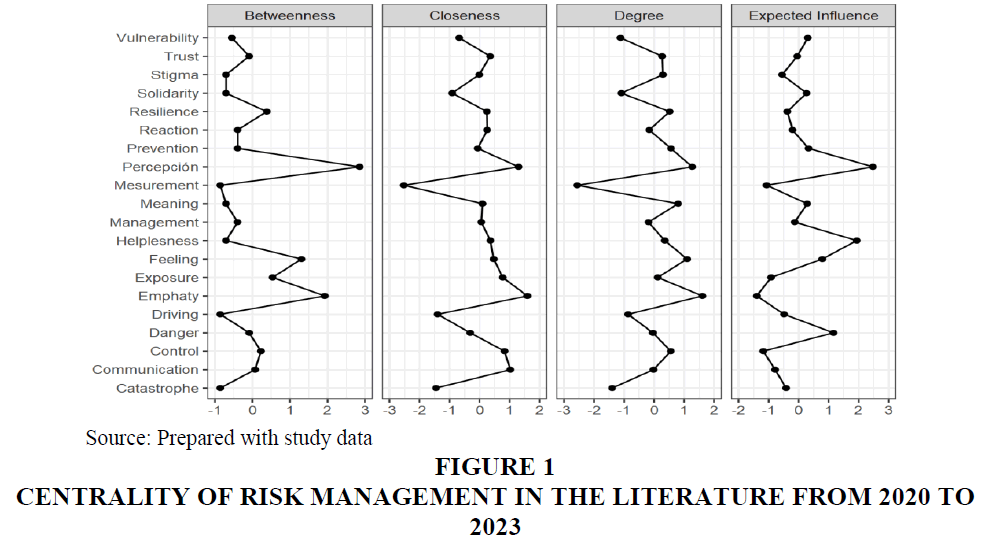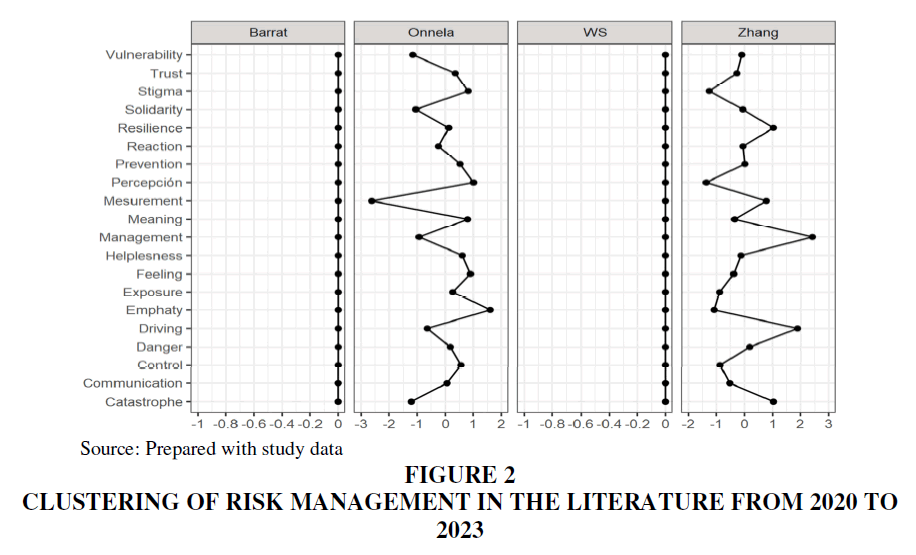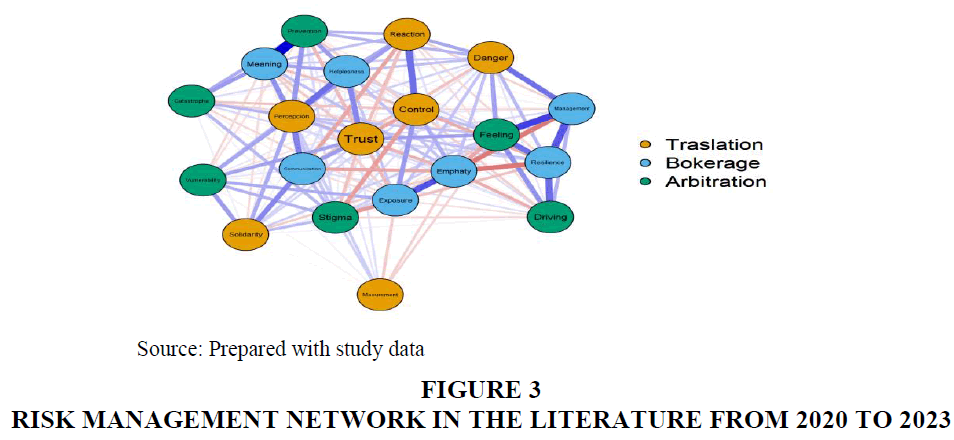Research Article: 2024 Vol: 27 Issue: 5
Comprehensive Disaster Risk Management in the COVID-19 Era
Victor Merino Cordoba, Universidad Catolica Luis Amigo, Colombia
Cruz Garcia Lirios, Universidad Autónoma de la Ciudad de Mexico, Mexico
Elias Alexander Vallejo Montoya, Universidad Catolica Luis Amigo, Colombia
Hector Enrique Urzola Berrio, Universidad Antonio Jose de Sucre
Citation Information: Cordoba V. M., Lirios C.G., Montoya E.A.V., Berrio H.E.U., (2024). Comprehensive Disaster Risk Management in the Covid-19 Era. Journal of Legal Ethical and Regulatory Issues 27(5) 1-6.
Abstract
The Comprehensive Disaster Risk Management (GIRD) is distinguished by including a series of interdisciplinary elements in its analysis phases. In this sense, the objective of this work was to establish a learning network focused on the review of specialized and updated literature from 2020 to 2023. A documentary, cross-sectional, exploratory, and correlational study was carried out with a sample of 100 students selected for their inclusion in the GIRD postgraduate course. The results show that the relationship structure is centered on risk perception and trust expectations as central axes of the agenda. The extension of the model is recommended to be able to include the effect of stigma towards authorities and trust towards technology as determinants of resilience.
Keywords
Risk Expectations, Risk Management, Risk Perception, Learning Network, Disaster Risk.
Introduction
Risk management theory is a set of principles, approaches, and practices that are applied to identify, assess, mitigate, and control risks in various areas, such as health, business, the environment, and engineering, among others (Huong et al., 2022). Risk management has become a fundamental discipline for making informed decisions and preventing adverse events.
The process begins with the identification of potential risks that may affect an organization or project (Abbasabadi-Arab et al., 2022). This involves analyzing and understanding the factors that could lead to undesirable events or uncertainties. Once the risks have been identified, their probability of occurrence and the impact they would have if they materialized are evaluated. This evaluation allows prioritizing risks and focusing resources on the most significant ones. Risk mitigation consists of developing strategies and actions to reduce the probability of adverse events occurring or minimize their impacts. These strategies may include preventive controls, contingency planning, or diversification of resources.
Risk management influences informed decision making (Hung et al., 2021). By having a clear understanding of risks and their implications, organizations and individuals can make more informed decisions and prepare to deal with uncertainties. Risk management is an ongoing process that involves constantly monitoring risks and the effectiveness of mitigation measures. As circumstances change, risk management strategies need to be reviewed and adjusted. Promoting a risk management culture involves fostering risk awareness and responsibility at all levels of an organization. This facilitates the early identification of potential problems and improves the ability to respond to unexpected events.
Effective risk management requires the participation of all relevant stakeholders and clear and transparent communication (Morsut, 2020). Collaboration between experts, decision makers and the community at large improve the quality of risk management. Risk management is applied in a personalized way according to the context and the type of risk in question. From financial risk management to environmental and public health risk management, this discipline offers tools and methodologies that adapt to different situations to increase resilience and response capacity in the face of adversities.
The Comprehensive Disaster Risk Management (GIRD) theory includes the central axes and themes of the regulatory framework (Cui et al., 2021). Self-management with respect to disaster risk reduction and management summits, programs, and strategies, highlight the importance of self-organization of civil society, since, in terms of complexity sciences, this area has not yet been studied. The difference between observing and analyzing the interaction of people, with respect to the analysis of self-organization is substantial. While the interrelation supposes laws that do not change, the self-organization is unpredictable. It means then that if disaster risks are immeasurable, then the response of those exposed to these risks is also unexpected.
Risk management measurement is essential to assess the effectiveness of the strategies and actions implemented to identify, assess and mitigate risks in an organization or project (Abbasabadi-Arab et al., 2021). By measuring risk management, it can be determined if practices are working as expected or if adjustments are required to improve the overall approach.
Key performance indicators (KPIs) are specific metrics used to assess performance and progress in risk management (Kong & Sun, 2021). These indicators may include the frequency of occurrence of adverse events, the effectiveness of the mitigation strategies implemented, and the reduction of the impact of the identified risks. Risk management generally involves the implementation of policies and procedures to address identified risks. Measuring the level of compliance with these policies and procedures is one way to assess the effectiveness of risk management and ensure that best practices are followed.
By conducting a trend analysis, one can see how risk management has evolved over time (Jia et al., 2022). This makes it possible to identify patterns, improvements or areas of concern in risk management over time. The risk culture in an organization is an important aspect of effective risk management. Measuring risk culture involves assessing how employees and stakeholders understand and act in the face of risks, and how awareness and responsibility for them is fostered.
Conducting surveys and asking for feedback from employees and collaborators can provide valuable information on the perception and effectiveness of risk management (Shah et al., 2020). This can help identify areas for improvement and potential gaps in the risk management approach. Measuring the resilience of an organization or project against adverse events is a way of indirectly evaluating the effectiveness of risk management. Higher resilience indicates that risk management measures have been successful in protecting and strengthening the organization against threats. The measurement of risk management must be a continuous process and be adapted to the specific needs and objectives of each organization. The information collected through these measurements should be used to make informed decisions, improve practices, and strengthen the organization's ability to meet the challenges posed by risks.
However, the measurement of risk management has not been done since its literature and the impact it has on risk science (Xu et al., 2020). Such scient metrics supposes a review and evaluation of the findings to be able to anticipate decision-making scenarios based on probability theory. Therefore, the objective of this paper is to carry out a scient metric study with the current and specialized literature on disaster risk management during the period between the pandemic from 2020 to 2023.
Are there significant differences between the structure of findings related to risk management published in the literature with respect to student evaluations?
H01: There will be significant differences between the theoretical structure and the empirical model established by student evaluations to the findings reported in the literature.
H02: Theoretical risk management is asymmetric to student criteria due to the impact of the pandemic on their academic training.
H03: The findings reported in the literature configure a structure oriented towards risk management derived from social stigma. In this sense, differences are expected regarding risk perceptions in students.
Method
Design
A documentary, cross-sectional, exploratory and retrospective study was carried out with samples of students (M = 21.3 SD = 4.3 age and M = 7'987.00 SD = 2'314.00 monthly income) in professional practices and social service in community health institutions and who evaluated sources indexed to international repositories.
Instrument
A questionnaire was used to activate the discussion in focus groups. The question was included: Are the risks socially constructed or are they natural and attributable to the authorities? In the COVID-19 era, are they still socially constructed or attributable to the authorities or to nature? Is risk management also socially constructed or should it be the responsibility of the authorities? The Delphi technique was used to evaluate the answers to the questions from a scale that goes from 0 = “not at all in agreement” to 5 = “quite in agreement”. The reliability of the questionnaire reached alpha and omega values between .765 and 0.790, with a threshold of 0.346 to 0.645 for validity.
Procedure
Participants were contacted through their institutional email. In writing and following the guidelines of the American Psychological Association (APA), the confidentiality and anonymity of the responses is guaranteed. In addition, non-remuneration for participation in the project is reported once its objectives and those responsible for carrying it out have been stated. The focus group to homogenize the concepts and the Delphi technique to evaluate the responses were carried out via Zoom.
Analysis
Data were captured in Excel and processed in JASP version 14. Centrality, clustering, and structuring coefficients were estimated. The hypotheses were contrasted with the adjustment and residual parameters. Values close to unity were assumed as evidence of non-rejection of the hypothesis except in the case of the residual, which is interpreted in the opposite way.
Results
Centrality is an instance of learning networks that distinguishes parent nodes from child nodes. In this sense, the four indicators of centrality related to intermediation, proximity, gradation and influence indicate that the central node is the perception of disaster risks. In other words, learning about disaster risks is gestated from the biases with which these phenomena are viewed in an immeasurable, unpredictable and uncontrollable way (Figure 1).
Clustering is another structural element of risk management, and the coefficients that measure it suggest that it is empathy and disaster risk management that lead the group of explanatory elements. That is, the elements of risk management revolve around perception, but are grouped under empathy and stewardship. It is a risk management system focused on the expectations of trust between the parties involved (Figure 2).
A network is read from left to right. The beginning suggests the input of information that will be processed and from which an output result is obtained. In this sense, the network begins with the arbitration dimension of catastrophic risks and culminates with administrative intermediation. In plain words, the risk management system depends on a structure of trust expectations that supposes a regulation of its public administration (Figure 3).
Discussion
The contribution of this paper to the state of the art lies in the establishment of a learning network of trust expectations and disaster risk management. In relation to risk management studies where trust is emphasized as a central element (Heinzlef & Serre, 2022), the present work corroborates this assumption. Regarding studies on stigma towards authorities in risk management, mainly in terms of prevention (Wang et al., 2021), this paper indicates that trust, when associated with public administration, generates empathy that would explain risk management that is replicable in catastrophic events, but not reproducible in low or high-risk events. If the literature warns that the acceptance of technology for the measurement, control and management of risks is predictive of prevention (Alam & Ray-Bennett, 2021), then the present study warns that such acceptance depends on trust towards the authorities, but when it is absent, then trust towards science and technology emerges. Therefore, the inclusion of stigma in risk management is recommended to explain distrust of authorities in the face of non-replicable catastrophic events such as volcanic eruptions. In fact, the limit of this work lies in the fact that the data was collected from a sample of non-experts in risk management. Consequently, it is necessary to compare the findings of this study with the specialized and updated literature on risk management according to experts.
Conclusion
The objective of the study was to establish the risk management learning network in a sample of postgraduate students from the same area in order to establish the structure of its dimensions and indicators. The results corroborate the theoretical model that includes trust between the parties involved as the central axis of the scientific agenda. In addition, the inclusion of stigma is recommended to explain the distrust between authorities and citizens in the prevention and reaction to disaster risks. The empirical testing of the model will also anticipate vulnerability and resilience scenarios.
References
Abbasabadi, A. M., MOSADEGH, R. A., Khankeh, H. R., & Biglarian, A. (2021). Development of hospital disaster risk management accreditation standards.
Abbasabadi-Arab, M., Mosadeghrad, A. M., & Asgari, N. (2022). Comprehensive evaluation of disaster risk management standards in the Iranian hospitals. Journal of Military Medicine, 24(4), 1231-40.
Alam, E., & Ray-Bennett, N. S. (2021). Disaster risk governance for district-level landslide risk management in Bangladesh. International Journal of Disaster Risk Reduction, 59, 102220.
Indexed at, Google Scholar, Cross Ref
Cui, P., Peng, J., Shi, P., Tang, H., Ouyang, C., Zou, Q., & Lei, Y. (2021). Scientific challenges of research on natural hazards and disaster risk. Geography and Sustainability, 2(3), 216-223.
Indexed at, Google Scholar, Cross Ref
Heinzlef, C., & Serre, D. (2022). Understanding and Implementing Urban Resilience for Comprehensive and Local Risk Management. In Disaster Risk Reduction for Resilience: Disaster Risk Management Strategies (pp. 103-128). Cham: Springer International Publishing.
Hung, K. K., Mashino, S., Chan, E. Y., MacDermot, M. K., Balsari, S., Ciottone, G. R., & Graham, C. A. (2021). Health workforce development in health emergency and disaster risk management: The need for evidence-based recommendations. International journal of environmental research and public health, 18(7), 3382.
Indexed at, Google Scholar, Cross Ref
Huong, T. T. L., Van Anh, D. T., Dat, T. T., Truong, D. D., & Tam, D. D. (2022). Disaster risk management system in Vietnam: progress and challenges. Heliyon, 8(10).
Jia, H., Chen, F., Pan, D., Du, E., Wang, L., Wang, N., & Yang, A. (2022). Flood risk management in the Yangtze River basin—Comparison of 1998 and 2020 events. International Journal of Disaster Risk Reduction, 68, 102724.
Indexed at, Google Scholar, Cross Ref
Kong, F., & Sun, S. (2021). Better understanding the catastrophe risk in interconnection and comprehensive disaster risk defense capability, with special reference to China. Sustainability, 13(4), 1793.
Indexed at, Google Scholar, Cross Ref
Morsut, C. (2020). Towards a standardization of EU disaster risk management. Standardization and Risk Governance, 43.
Shah, A. A., Gong, Z., Pal, I., Sun, R., Ullah, W., & Wani, G. F. (2020). Disaster risk management insight on school emergency preparedness–a case study of Khyber Pakhtunkhwa, Pakistan. International Journal of Disaster Risk Reduction, 51, 101805.
Indexed at, Google Scholar, Cross Ref
Wang, L., Gong, Z., Shi, L., Hu, Z., & Shah, A. A. (2021). Knowledge mapping analysis of research progress and frontiers in integrated disaster risk management in a changing climate. Natural Hazards, 107, 2033-2052.
Xu, Y., Qiu, X., Yang, X., Lu, X., & Chen, G. (2020). Disaster risk management models for rural relocation communities of mountainous southwestern China under the stress of geological disasters. International Journal of Disaster Risk Reduction, 50, 101697.
Indexed at, Google Scholar, Cross Ref
Received: 05-Jul-2024 Manuscript No. JLERI-24-15105; Editor assigned: 06-Jul-2024 Pre QC No. JLERI-24-15105(PQ); Reviewed: 20-Jul-2024 QC No. JLERI-24-15105; Revised: 25-Jul-2024 Manuscript No. JLERI-24-15105(R); Published: 01-Aug-2024


